Galerina heimansii Reijnders
Phylum: Basidiomycota - Class: Agaricomycetes - Order: Agaricales - Family: Strophariaceae
Distribution - Taxonomic History - Etymology - Toxicity - Identification - Reference Sources
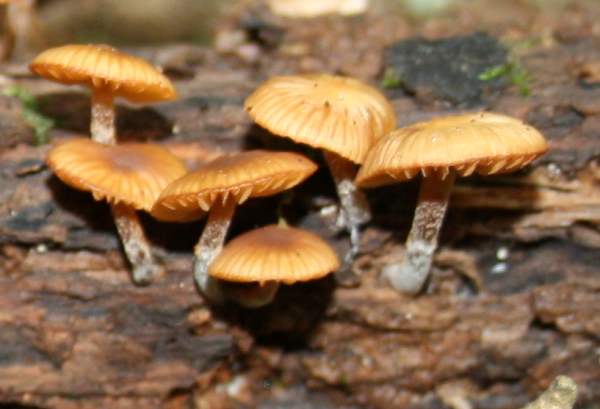
This pretty Galerina graminea, with its widely-spaced gills and dark-centred orange caps, is easily mistaken for one of the smaller rustgills, Gymnopilus species, but its widely-spaced gills and lined cap margins are important distinguishing features.
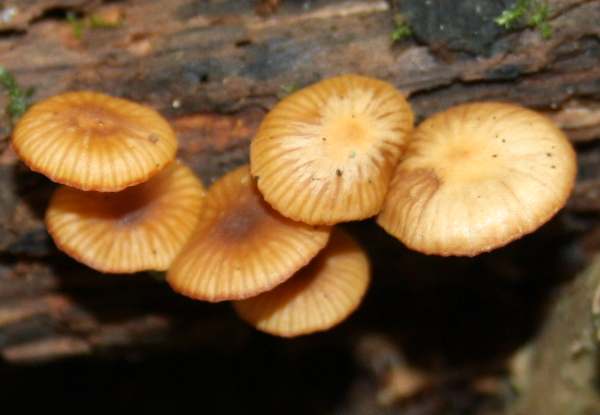
Distribution
Galerina heimansii is a rare find in Britain and Ireland. This species is also recorded, albeit rarely, in parts of mainland Europe including Denmark, Germany, Holland and France.
Taxonomic history
This attractive little mushroom was first described scientifically in 1969 by South-African born Dutch mycologist Albert Marinus Franciscus (Bert) Reijnders (1899 - 2002), who gave it the scientific name Galerina heimansii by which it is generally known today.
I know of no synonyms of Galerina heimansii.
Etymology
Galerina means 'like a helmet', while the specific epithet heimansii honours a Dutch botanist (I belive) Jacob Heimans (1889 - 1978).
Toxicity
Many common Galerina species are described as either inedible or suspect while some - for example Galerina marginata - contain deadly poisonous amatoxins which are the same kinds of substances that make the Deathcap Amanita phalloides so dangerous. Galerina heimansii is a rare find, and so there are surely more than sufficient reasons for not gathering this species to eat.
Identification guide
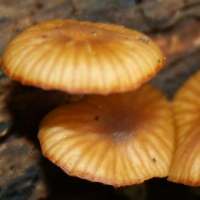 |
CapInitially conical or campanulate, becoming broadly convex, centre sometimes becoming slightly depressed but with a narrow central umbo; orange with a darker red-brown centre; strongly lined or grooved radially up to 3/4 from margin towards centre; 5 to 10mm in diameter when fully expanded.
|
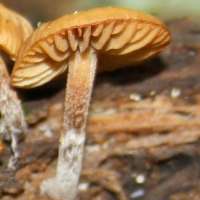 |
GillsWidely spaced, distant; ochraceous becoming more orange as the spores mature; adnate to adnexed. Basidia 2-spored. Cheilocystidia and pleurocystidia thick-walled, flask shaped 35-60 x 12-20μm. Stem1 to 1.5mm in diameter and 1.5 to 2cm tall; cylindrical or tapering slightly upwards from a slightly bulbous base, beige-orange and floury near apex; darker brown below then white and longitudinally fibrillose at the base. |
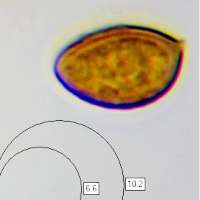 |
SporesEllipsoidal to almond shaped, 8-10.5 x 5-6μm; finely warty.
Spore printRusty brown. |
Odour/taste |
Indistinct or slightly raphanoid (of radish). |
Habitat & Ecological role |
Most often in carr woodland on rotten wood, usually alder Alnus spp.), willow (Salix spp.) or birch (Betula spp.) or on wet soil in swampy land. |
Season |
Early spring - early winter. |
Similar species |
Kuehneromyces mutabilis, a much larger mushroom with a pale cap centre and a darker margin. Flammulina velutipes, commonly called Velvet Shank, has a darker, velvety stem and leaves a white spore print. Galerina marginata is larger and has a mealy smell and a much less striate cap; it is deadly poisonous. |
Reference Sources
Galerina heimansii Reijnders, in Persoonia 1(1): 165 (1959)
Fascinated by Fungi, 2nd Edition, Pat O'Reilly 2016, reprinted by Coch-y-bonddu Books in 2022.
Dictionary of the Fungi; Paul M. Kirk, Paul F. Cannon, David W. Minter and J. A. Stalpers; CABI, 2008
Taxonomic history and synonym information on these pages is drawn from many sources but in particular from the British Mycological Society's GB Checklist of Fungi.
Acknowledgements
This page includes pictures kindly contributed by Simon Harding.
Fascinated by Fungi. Back by popular demand, Pat O'Reilly's best-selling 450-page hardback book is available now. The latest second edition was republished with a sparkling new cover design in September 2022 by Coch-y-Bonddu Books. Full details and copies are available from the publisher's online bookshop...


